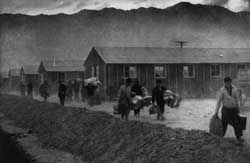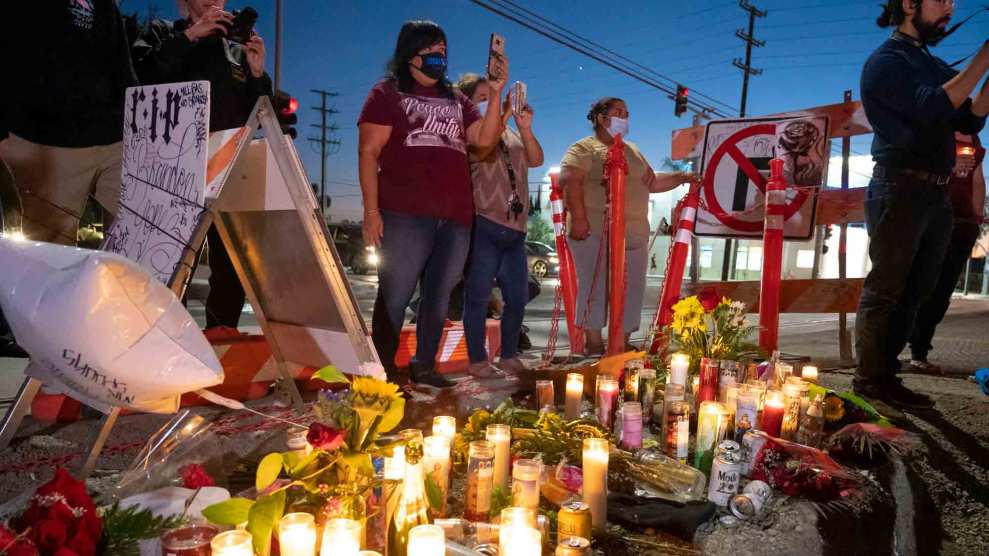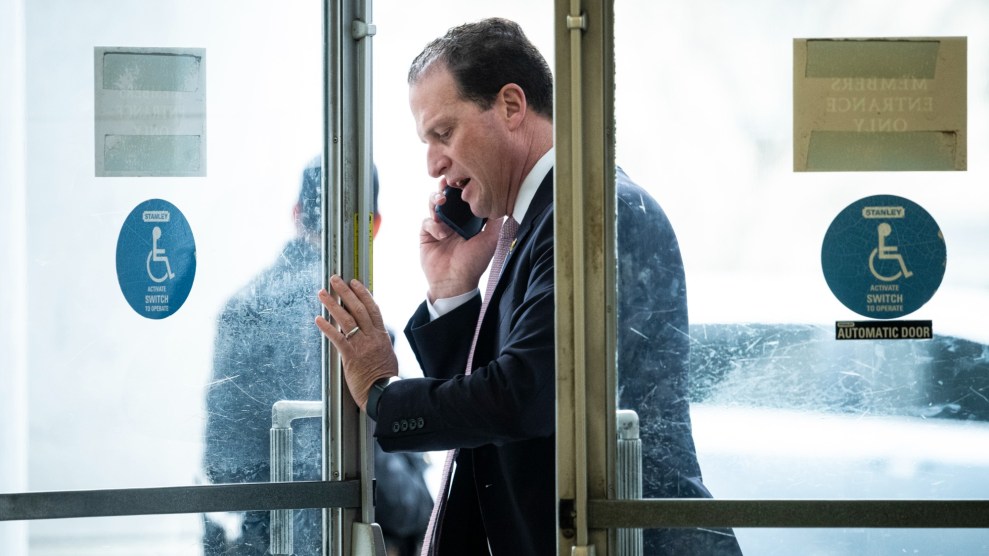
Since the end of World War II, Holocaust revisionists throughout Europe have vehemently denied that the extermination of 6 million Jews ever took place. The gas chambers? Zionist propaganda. Zyklon B? A heavy duty delousing agent.
But the rewriting of camp history isn’t just a European obsession. Over the last two decades, an equally determined band of homegrown revisionists has fought to paint a rosy picture of America’s own concentration camps: the ten “relocation centers” where over 120,000 Japanese Americans were imprisoned during World War II.
The debate over the historical interpretation of the American camps was reignited recently by an exhibit at Ellis Island entitled “America’s Concentration Camps: Remembering the Japanese American Experience,” an exhibit that freely uses the term “concentration camp” to describe the isolated encampments at such places as Manzanar and Tule Lake, Calif.; Poston, Ariz.; Topaz, Utah. Critics claim that the use of the term dishonors the victims of the Nazi death camps; supporters argue that the term is historically accurate, and point to the numerous academics, military officials, and even U.S. presidents who have preferred the term over the more euphemistic “internment camp” label.
But while the Japanese American and American Jewish communities bickered over semantics, few sought to downplay the historical and cultural importance of the Japanese American relocation camps: Thousands of American citizens snatched from their homes solely because of their ethnicity, without any evidence of wrongdoing. Whole families placed in barbed-wire encampments under armed guard for years, many losing all of their property in the process. Racial hatred and wartime hysteria justified under the guise of “military necessity” in what former Sen. Sam Ervin described as “the single most blatant violation of the Constitution in our history.”
Some American revisionists, however, see things differently, and they want you to know about it. Among their odder claims:
Despite the wackiness of some of their claims, the revisionists are not all talk. Over the last two decades, individuals have threatened to burn down buildings at Manzanar, defaced and fired rounds at a plaque designating the site as a State Historical Landmark, scrawled swastikas and racials slurs around the area, and even accused Manzanar supporters of treason. And while their numbers are small, their message is reaching ever greater audiences, thanks to the Internet.
Queen of the Revisionists
Until her death in 1996, Lillian Baker reigned supreme as the voice of the internment camp revisionists. A prolific writer, amateur historian, and founder of the International Club for Collectors of Hatpins and Hatpin Holders, Baker fought tenaciously against redress and reparations payments to Japanese American internees and the restoration of the Manzanar camp as a National Historic Site.
According to Sue Kunitomi Embrey, a longtime activist within the redress movement and founder of the Manzanar Committee, Baker was the movement’s chief researcher and historian. “She did a lot of research, but she would twist the material to her own advantage,” Embrey recalls. “But some things that she would write actually went against what she was going for,” Embrey adds. “They revealed what was really happening, although I don’t think she realized what she was doing at the time.”
Baker’s beef with the redress movement? Her primary argument was that the camps were a “military necessity,” a defense made during the war but later rejected by the national Commission on Wartime Relocation and Internment of Civilians. Baker’s followers supported the argument with their own bone-chilling accounts of foreign intrigue — accounts of repeated Japanese Navy attacks on the Oregon coastline, even a “top secret” revelation entitled “Yes, the Japanese Had an Atomic Bomb.”
While their stories often contain elements of truth — Oregon was hit by one deadly balloon bomb and a lone Japanese pilot did make an abortive attempt to start forest fires in the Oregon woods — they all tend to make the mistake of lumping together the Japanese military and Japanese American citizens. According to Bill Michael, director of the Inyo County-based Eastern California Museum and frequent combatant with the local historical revisionists because of his museum’s Manzanar exhibit, this inability to distinguish between the two groups is fairly common. “Quite often what happens is an intermingling of the Bataan Death March with this issue,” Michael says. “They’re equating the American citizens in this camp with the Emperor’s army, basically.”
Baker’s other argument — graphically illustrated in one of her books by photographs of smiling Japanese American schoolkids placed alongside grim images from the Nazi death camps — was that our “relocation centers,” by comparison, really were not all that bad. Baker defended this claim through selective photo editing, with the harsher, more revealing photos of the Japanese American camps ending up on her cutting room floor.
Baker also supported her “summer camp” argument by quoting liberally from a few ultraconservatives within the Japanese American community itself. Republican Sen. S.I. Hayakawa of California, who led the movement to declare English the official language of the U.S. and gained notoriety for his hardball tactics during the San Francisco State student strike, was one of Baker’s favorite sources. In one essay, Hayakawa attacked the proponents of the redress movement as “young Japanese-Americans following a fashion established by black militants” and defended the camps as necessary safehouses against rioting white mobs.
Other conservatives, like Shonin Yamashita, a San Diego resident who was interned in the camp at Poston, Ariz., suggested a “forgive and forget” approach. “Even most of those who say ‘Jap’ do not mean to insult us at all,” Yamashita argues. “Why can’t we just laugh it off? We lose more friends by protesting.”
Sadly, members of Baker’s own camp didn’t always heed Yamashita’s pleas for civility. Baker became infamous within the Japanese American community for her disruptive behavior at commission hearings on redress and the development of the Manzanar site, where she would often become verbally abusive and need to be restrained by security personnel. Following Baker’s lead, Baker supporter Howard Garber had to be forcibly removed from a 1996 commission meeting after he began yelling profanities and screaming “Where’s the media! Why isn’t this meeting being publicized?”
Of course, Baker herself had an explanation for the media silence: a government conspiracy that reached to the top levels of the U.S. political system. To illustrate her theory, Baker dredged up stories of how dissenting testimony about the camps was “held silent by political subterfuge,” citing a memo sent by Jesse Helms to the Oval Office that was supposedly “waylaid and/or covered-up by scandalous means.” (At press time, Helms’ staff could not confirm whether such a memo was ever sent.) A more benign explanation for the alleged cover-up would be that most politicians and media gatekeepers just ignored Baker’s voluminous mailings because of their hateful tone and weird conspiracy theories.
Web of Infamy
Although Baker depended on expensive and labor-intensive mailings to spread the revisionist word, the Internet has offered Baker’s disciples access to a whole new audience for a fraction of the cost. Many of the sites are tiny op-ed pieces like Robert Simmons’ “The Japanese Relocation,” a strange paean to a pre-war American utopia in which the U.S. “personified gaudy pride and ultra-nationalism” — in Simmons’ essay, this is portrayed as a good thing — and nobody needed “human rights.” One prominent site by retired Air Force Maj. Arthur D. Jacobs, tied into the World War Two Web Site Consortium, disparages the official history of the Japanese American camps while calling for a greater investigation into the internment of Europeans and European Americans.
One of the most complete Web sites on the subject is maintained by the Webb Research Group, an Oregon-based publishing house that prints Baker’s most popular revisionist texts and specializes in niche books about 19th-century Oregon history, Japanese attacks on U.S. soil, and other books of local interest. The Web site promos are written in the same hyperbolic language as the author’s own writings, and describe Baker’s work as “SO important that it resides in a special archive set aside at The Lillian Baker Collection at the Hoover Institution for War, Revolution and Peace at Stanford University.”
So important? Special archive? “Oh, I hope you won’t say that,” laughs Carol Leadenham, assistant archivist at the Hoover Institution, patiently explaining the library’s archival procedures — essentially, to collect anything with any research value on a given topic — and pointing out that Baker is a small part of Stanford’s huge, incredibly diverse holdings on the Japanese American camp experience. “Her books are not in a special collection,” she emphasizes. “She’s one of 4,000 collections.” (Similarly, the Web site’s claim that “the California Legislature is so afraid of [Baker’s] books that they’ve been banned in California public schools!” was shot down by Barbara Jeffus, school library consultant for the California Department of Education.)
But probably none of these small details will deter the surviving members of Baker’s camp, or her posthumous new recruits. Although both Embrey and Michael report less activity from Baker’s old guard of World War II veterans recently, a small group of Vietnam veterans has threatened to burn down buildings at the Manzanar site, and recently more angry letters have been coming from writers living outside of the Inyo County area.
Nor is the old guard packing it in. W.W. Hastings, a self-described “very extensive combat veteran” and heir apparent to the Lillian Baker legacy, has continued to be one of the most vocal opponents of the Manzanar historic site. A prolific letter writer, Hasting has written numerous typo-ridden letters to his local paper, the Inyo Register, castigating the “dedicated [Japanese] fanatics willing to starve and dye to defend Japan and the Emporer” and the museum personnel who are “acting like flower children of the 1960’s lacking character and integerity.”
Michael, who is very familiar with Hastings’ work, doesn’t put a lot of stock in the man’s editorial comments — or even his grasp on reality. “In letters to the editor, he’s recounted conversations he’s had with John Muir,” Michael says, noting that Hastings is clearly not old enough — he was born in 1922 — to have had a heart-to-heart with the famed naturalist. “John Muir died in 1914,” he says with a laugh. “He’s not playing with a full deck.”
Robert Ito is an assistant editor at Los Angeles Magazine and writes on Asian and Asian American issues for International Documentary, Asian Week, and Giant Robot.















